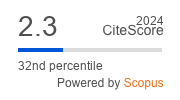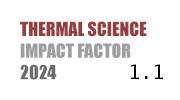THERMAL SCIENCE
International Scientific Journal
PROSPECTIVE STUDY ON MOLECULAR FRICTION OPPORTUNITIES, CHALLENGES, AND APPLICATIONS
ABSTRACT
This paper dives deep into the fascinating world of friction on a molecular scale. It applies the geometric potential theory to reveal some hidden secrets from the incredible mechanical properties of spider silk to the fascinating agglomeration of graphene. A new and promising concept is proposed: that friction can accumulate energy. This has the potential to revolutionize many fields in the future. When coupled with fractal theory, the molecular tribology offers a whole new window to design molecule-scale devices.
KEYWORDS
PAPER SUBMITTED: 2023-11-11
PAPER REVISED: 2024-07-07
PAPER ACCEPTED: 2024-07-07
PUBLISHED ONLINE: 2025-07-06
THERMAL SCIENCE YEAR
2025, VOLUME
29, ISSUE
Issue 3, PAGES [1679 - 1683]
- Kavokine, N., et al., Fluctuation-Induced Quantum Friction in Nanoscale Water Flows, Nature, 602 (2022), 84
- Tagimalek, H., et al., A Hybrid SVM-RVM Algorithm to Mechanical Properties in the Friction Stir Welding Process, Journal of Applied and Computational Mechanics, 8 (2022), 1, pp. 36-47
- El-Bahloul, S. A., Pre-Drilling Effect on Thermal Friction Drilling of Cast Aluminum Alloy Using Thermo-Mechanical Finite Element Analysis, Journal of Applied and Computational Mechanics, 6 (2020), Special Issue, pp. 1371-1379
- He, C. H., El-Dib, Y. O., A Heuristic Review on the Homotopy Perturbation Method for Non-Conservative Oscillators, Journal of Low Frequency Noise, Vibration and Active Control, 41 (2022), 2, pp. 572-603
- He, C. H., Liu. C., A Modified Frequency-Amplitude Formulation for Fractal Vibration Systems, Fractals, 30 (2022), 3, 2250046
- Zhao, L., et al., Promises and Challenges of Fractal Thermodynamics, Thermal Science, 27 (2023), 3A, pp. 1735-1740
- Fan, F. R., et al., Flexible Triboelectric Generator! Nano Energy, 1 (2012), 2, pp. 328-334
- Wang, Z. L., Triboelectric Nanogenerators as New Energy Technology for Self-Powered Systems and as Active Mechanical and Chemical Sensors, Nano, 7 (2013), 11, pp. 9533-9557
- Ozdemir, A. E., Triboelectric-Based Wind-Driven Nano-Power Energy Generator, Electric Power Components and Systems, 52 (2024), 7, pp. 1191-1199
- Zhang, Q., et al., Symmetry Effects on Attenuation Factors in Graphene-Based Molecular Junctions, Journal of Physical Chemistry Letters, 8 (2017), 24, pp. 5987-5992
- He, C. H., et al., Carbon-Contacted Single Molecule Electrical Junctions, Physical Chemistry Chemical Physics, 20 (2018), 38, pp. 24553-24560
- He, C. H., et al., Effect of Asymmetric Anchoring Groups on Electronic Transport in Hybrid Met-al/Molecule/Graphene Single Molecule Junctions, Chemphyschem, 20 (2019), 14, pp. 1830-1836
- He, C. H., et al., Charge Transport in Hybrid Platinum/Molecule/Graphene Single Molecule Junctions, Physical Chemistry Chemical Physics, 22 (2020), 24, pp. 13498-13504
- Kong, H. Y., He, J.-H., A Novel Friction Law, Thermal Science, 16 (2012), 5, pp. 1529-1533
- Han, C., et al., A High-Precision Numerical Approach to Solving Space Fractional Gray-Scott Model, Applied Mathematics Letters, 125 (2022), 1077596
- Aphinyan, S., et al., Numerical Study of Surface Agglomeration of Ultraviolet-Polymeric Ink and its Control During 3D Nano-Inkjet Printing Process, Journal of Polymer Science B, 56 (2018), 24, pp.1615-1624
- Konig, L., et al., Chemiluminescence in the Agglomeration of Metal Clusters, Science, 274 (1996), Nov., pp. 1353-1355
- Aphinyan, S., et al., Numerical Characterization of Ultraviolet Ink Fluid Agglomeration and the Surfac-tant Effect in Nanoinkjet Printing, Polymers for Advanced Technologies, 28 (2017), 9, pp. 1057-1064
- He, C. H., Liu, C., Fractal Dimensions of a Porous Concrete and Its Effect on the Concrete's Strength, Facta Universitatis-Series Mechanical Engineering, 21 (2023), 1, pp. 137-150
- He, C. H., et al., A Novel Bond Stress-Slip Model for 3-D Printed Concretes, Discrete and Continuous dynamical Systems-Series S, 15 (2022), 7, pp. 1669-1683
- Li, Y., et al., Fabrication and Characterization of ZrO2 Nanofibers by Critical Bubble Electrospinning for High-Temperature-Resistant Adsorption and Separation, Adsorption Science and Technology, 37 (2019), 5-6, pp. 425-437
- He, J.-H., et al., Piezoelectric Biosensor Based on Ultrasensitive MEMS System, Sensors and Actuators A: Physical, 376 (2024), 115664
- Ali, M., et al., Double Bubble Electrospinning: Patents and Nanoscale Interface, Recent Patents on Nanotechnology, 18 (2024), 37877565
- Ali, M., et al., Bipolymer Nanofibers: Engineering Nanoscale Interface via Bubble Electrospinning, Journal of Applied Polymer Science, 141 (2024), 5, e54878
- Tomlinson, G. A., A Molecular Theory of Friction, Philosophical Magazine, 7 (1929), 46, pp. 905-939
- Falk, K., et al., Molecular Origin of Fast Water Transport in Carbon Nanotube Membranes: Superlubric-ity vs. Curvature Dependent Friction, Nano Letters, 10 (2010), 10, pp. 4067-4073
- Cieplak, M., et al., Molecular-Origins of Friction - the Force on Adsorbed Layers, Science, 265 (1994), 5176, pp. 1209-1212
- Zhang, L. C., Tanaka, H., Towards a Deeper Understanding of Wear and Friction on the Atomic Scale - a Molecular Dynamics Analysis, Wear, 211 (1997), 1, pp. 44-53
- Mei, Y., et al., The Yellow River-Bed Evolution a Statistical Proof of the Mountain-River-Desert Conjecture, Thermal Science, 27 (2023), 3A, pp. 2075-2079
- Zhang, D. H., et al., Effects of Micro-Topography and Vegetation on Soil Moisture on Fixed Sand Dunes in Tengger Desert, China, Plants-Basel, 13 (2024), 11, 1571
- He, J.-H., et al., Unlocking the Plants' Distribution in a Fractal Space, Fractals, 31 (2023), 9, 2350102
- Li, X. X., He, J.-H., Nanoscale Adhesion and Attachment Oscillation under the Geometric Potential. Part 1: The Formation Mechanism of Nanofiber Membrane in the Electrospinning, Results in Physics, 12 (2019), Mar., pp. 1405-1410
- Li, X. X., et al., Gecko-Like Adhesion in the Electrospinning Process, Results in Physics, 16 (2020), 102899
- He, J.-H., An Elementary Introduction to Recently Developed Asymptotic Methods and Nanomechanics in Textile Engineering, International Journal of Modern Physics B, 22 (2008), 21, pp. 3487-3578
- Peng, N. B., He, J.-H., Insight into the Wetting Property of a Nanofiber Membrane by the Geometrical Potential, Recent Patents on Nanotechnology, 14 (2020), 1, pp. 64-70
- Yang, Z. P., et al., On the Cross-Section of Shaped Fibers in the Dry Spinning Process: Physical Explanation by the Geometric Potential Theory, Results in Physics, 14 (2019), 102347
- Tian, D., et al., Geometrical Potential and Nanofiber Membrane's Highly Selective Adsorption Property, Adsorption Science and Technology, 37 (2019), 5-6, pp. 367-388
- He, J.-H., et al., The Maximal Wrinkle Angle During the Bubble Collapse and Its Application to the Bubble Electrospinning, Frontiers in Materials, 8 (2022), 800567
- Qian, M. Y., He, J.-H., Collection of Polymer Bubble as a Nanoscale Membrane, Surfaces and Interface, 28 (2022), 101665
- Ali, M., et al., Double Bubble Electrospinning: Patents and Nanoscale Interface, Recent Patents on Nanotechnology, 18, On line first, pubmed.ncbi.nlm.nih.gov/37877565/, 2024
- Li, X. X., et al., Elucidating the Fractal Nature of the Porosity of Nanofiber Members in the Electrospinning Process, Fractals, On-line first, www.worldscientific.com/doi/abs/10.1142/S0218348X24501093, 2024
- Atif, R., Inam, F., Reasons and Remedies for the Agglomeration of Multilayered Graphene and Carbon Nanotubes in Polymers, Beilstein Journal of Nanotechnology, 7 (2016), Aug., pp. 1174-1196
- Li, Z. L., et al., Effect of Functional Groups on the Agglomeration of Graphene in Nanocomposites, Composites Science and Technology, 163 (2018), July, pp. 116-122
- Lamoreaux, S. K., Demonstration of the Casimir Force in the 0.6 to 6 mu m Range, Physical Review Letters, 78 (1997), 1, pp. 5-8
- Mohideen, U., Roy, A., Precision Measurement of the Casimir Force from 0.1 to 0.9 μm, Physical Review Letters, 81 (1998), 21, pp. 4549-4552
- Zuo, Y. T., Variational Principle for a Fractal Lubrication Problem, Fractals, 32 (2024), 5, 2450080
- He, J.-H., Nano Bubble Dynamics in Spider Spinning System, Journal of Animal and Veterinary Advances, 7 (2008), 2, pp. 207-209
- He, J.-H., From Spider Spinning to Bubble Electrospinning and From the Wool Structure to Carbon Super-Nanotubes, Materials Science and Technology, 26 (2010), 11, pp. 1273-1274
- Wang, P., et al., Energy Absorption in Friction-Based Stab-Proof Fabrics and the Puncture Resistance of Nanofiber Membrane, Thermal Science, 22 (2018), 1A, pp. 39-41
- Qian, M. Y., et al., Enhanced Piezoelectric Performance of PVDF Nanofibers by Biomimicking the Spider's Long Liquid Transport, Chemical Engineering Journal, 483 (2024), 149159
- Zuo, Y. T., Liu, H. J., Is the Spider a Weaving Master or a Printing Expert? Thermal Science, 26 (2022), 3B, 2471-2475
- He, C. H., et al., Controlling the Kinematics of a Spring-Pendulum System Using an Energy Harvesting Device, Journal of Low Frequency Noise, Vibration and Active Control, 41 (2022), 3, pp. 1234-1257
- He, J.-H., Abd-Elazem, N. Y., The Carbon Nanotube-Embedded Boundary Layer Theory for Energy Harvesting, Facta Universitatis-Series Mechanical Engineering, 20 (2022), 2, pp. 211-235
- Zuo, Y. T., et al., Gecko-Inspired Fractal Buffer for Passenger Elevator, Facta Universitatis-Series Mechanical Engineering, On-line first, doi.org/10.22190/FUME240314022Z, 2024
- Zuo, Y. T., On Murray Law for Optimal Branching Ratio, Fractals, On-line first, doi.org/10.1142/S0218348X24500920, 2024

